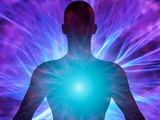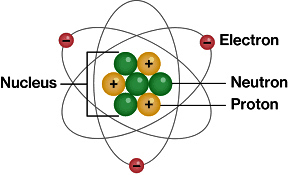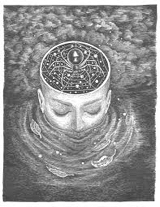Science and knowledge
Neutrally positive positively neutral
Abstract
“Our Centre is neutrally positive, positively neutral — a positive without any negative.” What to make of this, a received flash? Is it an intuitive dawning or an intellectual arrival, at that moment, rising as a hitherto unseen and unrealised dimension and expansion as the received? The query arises, maybe because of many reasons, of which, two are prominent. One being the ‘human’ tendency to be always ‘right’, and another, which makes its presence felt as the yearning to be ever guided by the ‘highest order’, the Will of the Divine, the Centre, yearning for the constant conscious reception and transmission as per the Central Will — more so, when one has even once, however fleetingly, experienced the Guidance…
The context that forms the flash is the ‘centre of an atom’, not different from the Centre and Source of all and everything.
The nucleus of an atom, comprised of the positively charged proton and the neutral neutron, exercises its pull on the orbiting electrons (because of the protons). A mutual attraction, between the positive and the negative, is in operation. Also, the electron is held in its place by the centrifugal force, which, countering this force of attraction ensures that the distance is maintained between the orbiting electron and the proton-containing nucleus so that the electron does not fall into the nucleus and the atom does not lose its identity. It could also be said that this mutual attraction, between the proton and the electron, does not allow the centrifugal force to dominate, whereby the electron is stopped from flying away! It is kind of a dynamic equilibrium, between the force of attraction and the centrifugal force — and could also be deemed akin to a harmonious tug of war.
At the same time, the farther is the electron from the nucleus — in an orbit far from the nucleus — the lesser is the influence of the nucleus on the electron, lesser is its hold, lesser is the electron’s response to the nucleus, to the positively charged proton in the nucleus (which is in combination with the chargeless but having some mass, neutron, its electrical neutrality according it the name of neutron). The consequence of this lesser hold: such an electron can be given up by the atom, in a conducive and provocative condition. Hence, the atoms and molecules, of chemical elements and compounds are found to interact, combine, bond, undergoing cleavage and formation of bonds (of different types) with one another — that is, externally (as also undergoing internal rearrangements) — through such electrons. Of course, not just the position of the electrons is the determinant; other factors too play their roles as they too exist, not in isolation but forming the integral, hence influenced by the collective, as the collective is influenced by the individual.
But what brings and forms this flash: It is the position of electrons and the hold, relative, of the nucleus on it, changing with the change of its distance from the nucleus. Before proceeding on to the nucleus, one more aspect, in the context, prods for expression through reiteration. The outermost shell, among all others, is under the least influence of the nucleus. Hence, it is the electrons in the outermost shell, outermost orbit of the atom that are most receptive, prone, susceptible, gullible, proactive, reactive — and hence, engage and indulge in the interactions, leading to the specific outcomes under the given entirety of the condition, the internal as well as the external forming the integral condition and state.
Now to the nucleus… and to the revelation… the flash of insight… or whatever it can be called… the Centre of our very being and of everything... comes up as a query, a kind of self-answering query: “Neutrally positive, positively neutral? Or just positively neutral? Or is it neutrally positive?”
As to why it comes up as a query: Because the Divine is without any duality, is non-judgmental…
The centre, the nucleus of an atom is comprised of both a positive component, the proton, as well as a neutral component, the neutron. And the nucleus of an atom is found and felt (as and through the flash received) to dissolve into the Centre, the Divine… the Source of all. And why not, as the atomic expression too is Its, though the atom and its constituents are held and hailed as our (and of everything) fundamental seed and kernel, Science seeing only and endeavouring to explain matter, reducing and deconstructing everything in terms of matter, matter-of-factly, but considering not the Fundamental, the only Fundamental.
Limitation of physical science: the cause
Why the Fundamental eludes, and hence the happenings delude — the interludes of incessant occurrences and recurrences seemingly intruding and disrupting — lies in the very prelude. It is the ignorance, shrouding and veiling Reality, which determines the meanings of being and life for us, and thus, determines our ways and means, which are, consequently, enoneous, deficient and misleading.
“It is evident that however much we may analyse the physical and sensible, we cannot by that means arrive at the knowledge of the Self or of ourselves or of that which we call God (1).”
The means has to be different, then.
“If, then, there is a Self, a Reality not obvious to the senses, it must be by other means than those of physical Science that it is to be sought and known. The intellect is not that means (2).”
However much the intellect is refined and the intelligence is luminous, it is only the luminosity of Reality that can lead us to the true functioning, can guide us to override the confounding and land us ashore with the Reality, transformed and healed. The intellect and intelligence, however much on the higher side, still are subjugated to the thinking mind alone, are not pure and cannot be purified, cannot be cleansed of the many impressions and imprints acquired, even and more often unbeknownst, those influences from the collective, and those consequent experiences in the past, and those concurrent and corresponding perceptions which we find difficult to let go, those impulsions, those ‘lower movements’ which become habitual in keeping with the state of our nature, presenting them as the statements of our nature. The very word, ‘understanding’, becomes a misnomer, intellect and intelligence finding themselves falling well short of explanations for the occurrences and their recurrences… That, which is not free from such impulsions and dependences, is not pure.
“The second cause of impurity in the understanding is the illusion of the senses and the intermiscence of the sense-mind in the thinking functions. No knowledge can be true knowledge which subjects itself to the senses or uses them otherwise than as first indices whose data have constantly to be corrected and overpassed. The beginning of Science is the examination of the truths of the world-force that underlie its apparent workings such as our senses represent them to be; the beginning of philosophy is the examination of the principles of things which the senses mistranslate to us; the beginning of spiritual knowledge is the refusal to accept the limitations of the sense-life or to take the visible and sensible as anything more than phenomenon of the Reality (3).”
The Central Will, the pull of the nucleus
Thus, the way out: the “central will”, to which the Mother and Sri Aurobindo call to, remind of, make aware of this “central will”, its presence — undeniable ultimately — and impulsion and its growing impulsion to the exclusion of all else, to finally become the whole and hence sole impulsion impacting every poise, state and strata of consciousness. It is essential that right down to the nether depths of the Inconscient its pull is experienced and adhered to, in this process and purpose of integral transformation.It is their Word, encouraging and guiding, that despite many a stumbling, the “central will” be aspired for, accessed and surrendered to, as matters, essentially, being always centred, as only then Matter realises realises its purpose, manifesting the centre of all and everything, the Divine.
Now this “central will”, the Centre’s Will, comes up as the pull of the nucleus… and our departure from it, corresponding to and resultant of the myriad expressions of Ignorance, are received in that flash as: the distance of the departure from the Centre decides and results in the departure, the influence reflecting not the “central will”, with the distance increasing from the Centre, the consciousness not the “true consciousness”. And yet, it is the state to be at, only and constantly.
“The consciousness that is aware of the Divine and the Truth and does not look at things from the ego [is the true consciousness] — it is wide and calm and strong and aspires to union and surrender —it is many things besides, but this is the essential (4).”
“In the world, as it is, the goal of life is not to secure personal happiness, but to awaken the individual progressively towards the truth-consciousness (5).”
“It is not in order to be happy that we are upon earth, for in the present conditions of terrestrial life happiness is an impossibility. We are upon earth to find and realise the Divine, for the Divine Consciousness alone can give true happiness (6).”
And still the wavering happens, from this state, increasing with the ‘distance’. Our mind is entangled in — which it is, most of the time — its formed and ever-forming web of thoughts, receiving, allowing and transmitting the constant influx of the interactions and ‘intra-actions’, the resultant flux running the show. The Witness, the Sanctioner, watches the play, knowing when to hold and release the Light for the screenplay of life, making faith of quintessence.
“…however we err or stumble, our force of faith will sustain us. When we cannot see, we shall know that God withholds the light, imposing on us error as a step towards knowledge, just as he imposes on us defeat as a step towards victory (7).”
Through all this, towards Itself the Divine leads, making also essential the “two types of passivity”.
“In order that the understanding may not interfere with our attainment to real knowledge, we have to reach to that something more and cultivate a power exceedingly difficult for the active intellectual thinker and distasteful to his proclivities, the power of intellectual passivity. The object served is double and therefore two different kinds of passivity have to be acquired (8).”
So, to get to, get back to and commit to the “central will”, the will has to be there, and even this will seemingly comes with the lessening of the distance and departure from the Centre, from the “central will”, coming out the very first utterances of “Let Thy Will be done and not mine (9).”
“Put yourself with all your heart and all your strength into God’s hands. Make no conditions, ask for nothing, not even for siddhi in the yoga, for nothing at all except that in you and through you his will may be directly performed. To those who demand from him, God gives what they demand, but to those who give themselves and demand nothing, he gives everything that they might otherwise have asked or needed and in addition he gives himself and the spontaneous boons of his love (10).”
Consecration absolute
This utterance of surrender has to become one’s very breath, this utterance first — however intellectual or a result of a profound experience, realisation of one’s nothingness and of the sovereignty of the Unconditional Love of the Almighty happening synonymously — has to be stabilised, the consecration requiring the completeness of absoluteness and the frequency of constancy.
Can this happen in one day, even as the mind yearns and strives, having once had the taste of the Light of surrender, when every moment it struggles — “Our thoughts cover the everlasting Light, (11)” — faltering, flirting with its ‘doership’, impulsions of the ego ruling? Yet, this is the call to reach the Goal… and in the journey, the very surrender becomes thus the Goal too, holding the key, holding one to the “central will”.
A Positive without any negative
But as the flash stated that the nucleus is akin to the Centre, and though cannot explain the experienced truth in it, it is followed by those queries which, too, couldn’t ignore or challenge, though interestingly, they in no way challenged the flash! Simply prompted and prompts an exploration.
The Divine, the Absolute, has no duality. So and but if it is likened to the positively charged nucleus, it is bound to have a negative counterpart. But the Divine is bound to nothing, the relative not Its ‘relative’.
Anything positive is deemed as the attribute of the Divine, positivity accessed and embodied divinity redeemed, the Realisation calling for the moment-to-moment living of the Divine’s attributes, solely identifying with and finding one’s identity in the Divine through absolute surrender.
“If man surrenders totally to the Divine, he identifies himself with the Divine (12).”
So, ‘logically’ and essentially, all that is negative is undivine. But nothing exists which is not the Divine — could be the distorted, misinterpreted, ignorant and misrepresented expression of the Divine, as and through the Inconscient. Then, this Centre — our Nucleus, the Positive without any polar counterpart — how do we describe It, which calls to equanimity, and call the Mother and Sri Aurobindo to be ever “vigilant”, having a quiet, calm and silent mind, and as is the Biblical exhortation, “Be still and know that I am God” (13)?
That is, as much can the words describe, what do we ascribe to the Divine, the Opposite-less Positivity and Neutrality, Its non-judgmental nature?
Present themselves these words, tumble in sequence, arranging and rearranging themselves, joyously and yet tentatively: The Nucleus, the Centre, akin to the combination of proton and neutron (with electrons being our varied thoughts, emotions, feelings, words, actions, varying according to the orbit, the layer and level of consciousness), could be hailed as ‘Neutrally Positive, Positively Neutral’.
The Mother soothes that Truth is found in diversity and not in uniformity. “The truth is neither in separation nor in uniformity. The truth is in unity manifesting through diversity (14).”
The Nucleus is neutral and is Positive without a negative. This cannot be denied. So is it with the atom — its nucleus formed of neutral neutron and positive proton! As to whether these words that describe the Centre, ‘Neutrally Positive, Positively Neutral’, are only intellectual reflection and reception or intuitive, one cannot definitely vouch and as counsels Sri Aurobindo, that can be discerned only when the Light is invoked and sheds Itself on it.
“In the first place we have seen that intellectual thought is in itself inadequate and is not the highest thinking; the highest is that which comes through the intuitive mind and from the supramental faculty. So long as we are dominated by the intellectual habit and by the lower workings, the intuitive mind can only send its messages to us subconsciously and subject to a distortion more or less entire before it reaches the conscious mind; or if it works consciously, then only with an inadequate rarity and a great imperfection in its functioning. In order to strengthen the higher knowledge-faculty in us we have to effect the same separation between the intuitive and intellectual elements of our thought as we have already effected between the understanding and the sense-mind; and this is no easy task, for not only do our intuitions come to us incrusted in the intellectual action, but there are a great number of mental workings which masquerade and ape the appearances of the higher faculty. The remedy is to train first the intellect to recognise the true intuition, to distinguish it from the false and then to accustom it, when it arrives at an intellectual perception or conclusion, to attach no final value to it, but rather look upward, refer all to the divine principle and wait in as complete a silence as it can command for the light from above. In this way it is possible to transmute a great part of our intellectual thinking into the luminous truth-conscious vision, — the ideal would be a complete transition, — or at least to increase greatly the frequency, purity and conscious force of the ideal knowledge working behind the intellect. The latter must learn to be subject and passive to the ideal faculty (15).”
Central Will, the healer…
The only subjection called for is that to the Divine, to Its Will, the subjection forming our purpose, calling to our integral transformation, assuring and insuring our consummate liberation and healing, ensuring it unfailingly. It is about dissolving in the Centre, in the Nucleus, the Will, the Centre’s, and that too can happen only by the Grace of the “central will”.
“Keep faith in your spiritual destiny, draw back from error and open more the psychic being to the direct guidance of the Mother’s light and power. If the central will is sincere, each recognition of a mistake can become a stepping-stone to a truer movement and a higher progress (16).”
“Consecration is the consummation, when the Light has illuminated all the parts of your being, with a central will acting on the feelings, impulses, thoughts, emotions, activities, directing them always towards the Divine and when you move no more from darkness to light or from falsehood to truth or from misery to happiness but from light to more light, from truth to greater truth, from happiness to increasing happiness (17).”
“It is in a sincere consecration to the Divine that we can find relief from our too human sufferings (18).”
References
1. Sri Aurobindo. Sri Aurobindo Birth Centenary Library, Volume 20. Pondicherry: Sri Aurobindo Ashram Trust; 1970, p. 287.
2. Ibid., p. 287-8.
3. Sri Aurobindo. Complete Works of Sri Aurobindo, Volume 23. Pondicherry: Sri Aurobindo Ashram Trust; 1999, pp. 313-14.
4. Sri Aurobindo. Complete Works, Volume 28. 2012, p. 99.
5. The Mother. Collected Works of the Mother, Volume 14. 2nd ed. Pondicherry: Sri Aurobindo Ashram Trust; 2004, p.7.
6. Ibid., p.7.
7. Sri Aurobindo. SABCL, Volume 17. Pondicherry: Sri Aurobindo Ashram Trust; 1971, p.157.
8. Sri Aurobindo. Complete Works, Volume 23. p. 315.
9. The Mother. Collected Works, Volume 14. p. 103.
10. Sri Aurobindo. Complete Works, Volume 13. 1998, p. 74.
11. Sri Aurobindo. SABCL, Volume 28. 1970, p. 170.
12. The Mother. Collected Works, Volume 14. p.108.
13. Available from: https://biblehub.com/ psalms/46-10.htm Accessed 27th May 2019.
14.The Mother. Collected Works, Volume 14. p.198.
15. Sri Aurobindo. SABCL, Volume 20. pp. 301-2.
16. Sri Aurobindo. SABCL, Volume 25. 1972, p. 155.
17. The Mother. Collected Works, Volume 14. p. 99.
18. Ibid., p. 100.
Sushmita Mukherjee is an author and freelance editor, residing in Kolkata.
Share with us (Comments,contributions,opinions)
When reproducing this feature, please credit NAMAH,and give the byline. Please send us cuttings.








